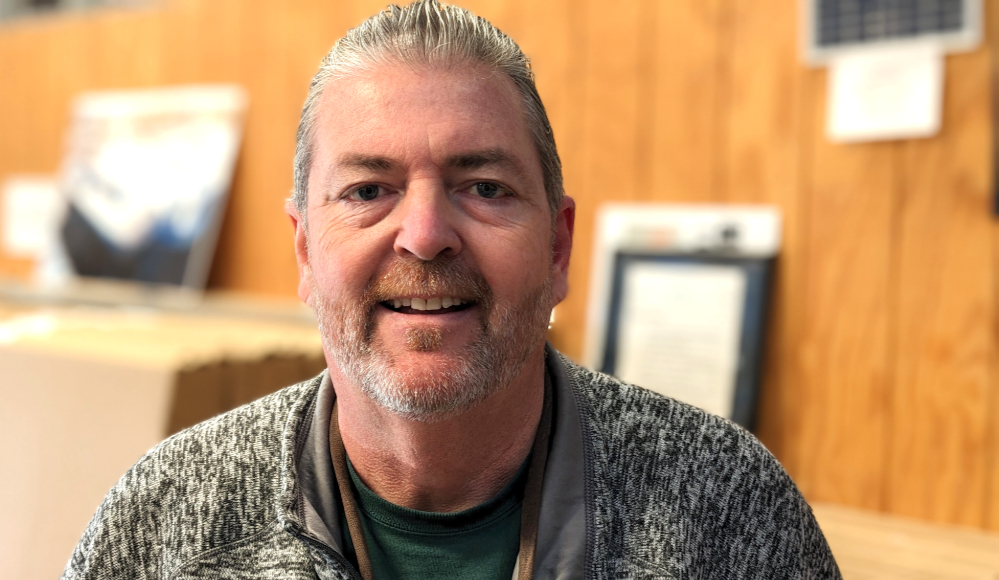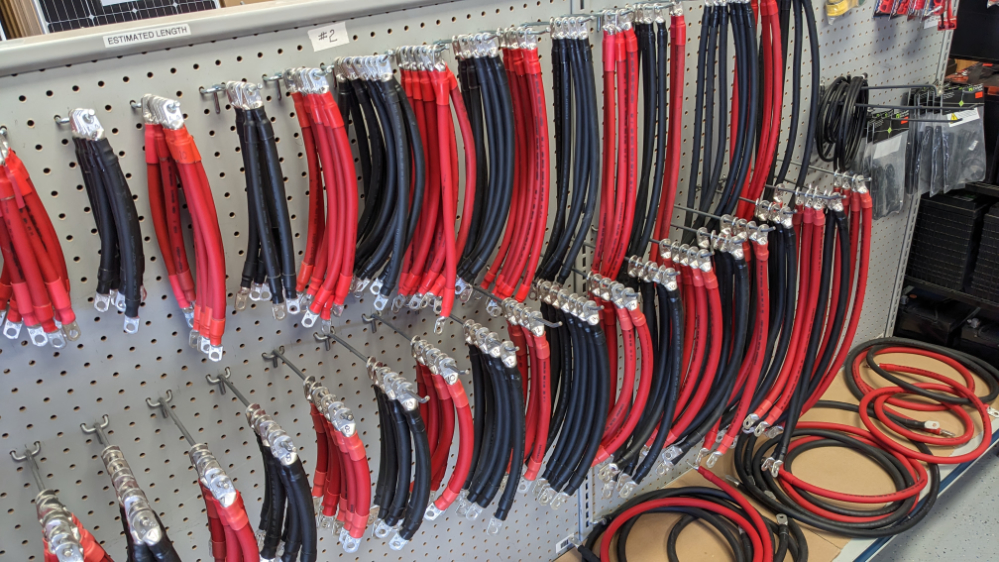CRAIG SHACKELFORD has been into electronics since he was a child. He started using ham radios when he was 13, graduated college with an electrical engineering degree, and worked for a major electronics company. He decided corporate life wasn’t for him. Now Craig is the owner of Discount Solar in Quartzsite, Arizona, and a licensed electrical contractor. So I talked to him about mobile solar energy systems.

“I’ve been doing this for 33 years. I haven’t achieved perfection but I’m a licensed electrician and an electrical engineer. So, we do stuff differently than everybody else. We read the manual,” he chuckled. “I grew up with a TV repairman as my dad, and one of the other guys here worked for Cray computers and for the government.”
The bulk of his business is designing and installing solar setups in large RVs and travel trailers. Many of the customers come from regions where generators and shore power are popular because tree cover makes solar less practical. But while they’re spending the winter boondocking in the desert they see solar’s advantages.
“There’s no two systems the same. We spend about 20 minutes talking to people to find out how much generator they use, how much TV they watch, if they have Internet, what appliances they want to power, that sort of stuff. Then we figure how many panels they need, what size battery bank. And we find out what they might already have, whether it would work with our design. Maybe they have an old inverter, or maybe they want to upgrade to lithium batteries and need an appropriate charge controller. And then once we get that all figured out, they bring the rig down here, we put like six guys on it, get it out that same day.”
But Discount Solar’s business is expanding beyond large RV systems. “We’re seeing more of the people that are in vans and living in their cars and in tents and stuff. And so we’re seeing the people with the little portable power packs that are really aren’t our traditional customer base. So people are kind of pushing us outside of what we normally do.

“People come in with these self-installs. They’ve watched the YouTubers who say, ‘Let me show you how to install the solar system. You can do just like me.’ But they forget some of the details. I can’t condemn them because I refer to YouTube for things outside my expertise, like my car for instance.
“Some DIYers know their stuff, though. They’ll buy their panels, controllers and stuff online to save some money and then come in here to buy connectors, fuses and cables that we custom make.
“We also see installations by RV shops that really aren’t up to the task. There are some persistent offenders out there doing hack jobs, either out of ignorance or to rip people off. It’s like they own one roll of wire and use it regardless of the size the job actually requires. Or they run 20 feet of wire from the batteries at one end of the RV to the inverter at the other end. Or they don’t ground things properly or install fuses.”

CRVL: What are the most common problems you see?
“The biggest thing is cable size. That’s the number one thing, because most everything we see is stuff that’s just not installed according to the instructions. There’s a chart, and any reputable inverter comes with a manual that tells you what size cable to use. You need to use the heaviest wire that will connect to the device and make it as short as possible so you minimize resistance.
“Then there’s the wrong sized charge controller. They don’t understand the difference between connecting panels in series or parallel and how it affects the voltage output to the controller, and that different controllers are designed to handle higher or lower voltages.
“And then there’s stuff that just wears out, like the converter-chargers they normally put in the rigs when they build them. They’re usually 12 to 15 years old and there’s an electromechanical transfer switch that clicks every time you plug in, or every time you start to generator.
“We do troubleshooting, even down to the component level. Sometimes we can replace a component or a circuitboard instead of the entire device.

Power stations, which combine the battery, charge controller, and inverter in one package, solve some of the system building puzzles and may become a more popular choice than the classic piece-built system. That is at least the case for those who aren’t in large RVs. Then it becomes a matter of whether there’s a Goldilocks just-right power station that fits your needs, space, and budget.
If you’re still a fan of the flexibility of DIY systems, here are the most common things to watch for.
Common errors when installing solar power
Inadequate power generation: One of the most common mistakes is installing solar panels that do not generate enough power for your needs. This can happen if you underestimate your power requirements or purchase low-quality or undersized panels.
Poor placement of solar panels: Solar panels need to be placed in a location that receives maximum sunlight to generate maximum power. Placing them in a shaded area or in a spot that does not receive enough sunlight can reduce their efficiency.
Incorrect wiring: Wiring is an essential component of any solar power system. Incorrect wiring or using the wrong gauge wire can lead to power loss, overheating, and even fire.
Inadequate battery storage: Your RV solar power system needs to be paired with the right battery storage system. If your battery storage is too small or underpowered, you may not have enough energy to power your RV when you need it.
Improper charge controller selection: The charge controller is responsible for regulating the flow of energy between the solar panels and the battery storage system. Choosing the wrong controller can lead to overcharging or undercharging the batteries, which can damage them.

Since Craig says incorrect wiring is the most common mistake, here are things to avoid:
Using the wrong wire gauge: The wire gauge determines how much current the wire can handle. If you use a wire that is too small, it can overheat and even cause a fire. Using a wire that is too large can be expensive and unnecessary. Make sure to choose the right wire gauge based on the amperage of the system.
Not using the right type of wire: Not all wires are created equal. The wires used in an RV solar power system need to be able to withstand the elements, including high temperatures and exposure to UV radiation. Make sure to use wires that are designed for use in solar power systems and are rated for outdoor use.
Poor connections: Connections between wires and components need to be secure and tight. Loose connections can cause power loss and create a fire hazard. Make sure to use appropriate connectors and crimping tools to ensure a secure connection.
Overloading circuits: RVs have limited electrical capacity, so it’s essential to avoid overloading circuits with too much power. Make sure to size the wiring correctly to avoid overloading circuits, which can cause overheating and even fire.
So, if you read the manual and make the right choices, the only time you’ll need to see someone like Craig is to get your cables, connectors and fuses, not to have him fix your mistakes.

Good stuff, looks like a candy store to me!
> like the inverter-chargers they normally put in the rigs when they build them
Might want to check the tape; he likely said “converter/chargers” here.
There was a lot of background noise. I’ll correct it.
Our solar was installed by the previous rig owner by the RV dealership. We were having issues, and when we went to a solar shop, opened the front panel of the fifth wheel, the guy said (from 6 feet behind me) “I see your first problem already.” What? “What’s that?” “Those are *audio* cables, not battery cables. (It wasn’t our main problem, but we had it re-done.)
After that, I always recommend to people to use a solar shop, NOT a dealership.
We also had the battery cables reconfigured according to this whitepaper:
https://www.solar-electric.com/lib/wind-sun/Iota_balanced_charging.pdf
Super helpful
Wonderful interview, photos and information. As Meredith said, super helpful. Thank you Al?
I bought a Alpicool C20,12 volt 21 quart car fridge am I am totally lost at what size charger and panels to get. I have a $500 budget for this and I plan on putting it in a minivan. Could someone please give me some advice. Thanks.
I have to assume you mean you have $500 on top of the cost of the fridge, otherwise I’m sorry but there is currently no way to make this happen. After consulting with Bob, whom I hoped might know of some new tech out there, we came to the conclusion that you’d need to do something like this:
Renogy makes a $327, 200 watt, hard folding solar suitcase for $327 (https://tinyurl.com/y3dmnry9) that includes the controller and cables. That would take care of the first two essential parts.
Then you could get a 100 Ah deep cycle AGM battery like this one (https://tinyurl.com/5dka9t9z) for $160.
Finally, you’d need a 12V socket like this (https://tinyurl.com/4cbnytj5) to plug the fridge into.
I hope this helps you out.